How to Find Lookalike Companies for Sales Prospecting
How to Identify and Target Companies That Mirror Your Best Customers for Higher Sales Success
Blogby JanJuly 07, 2025

Finding companies similar to existing customers shouldn't feel like searching for a needle in a haystack. Yet most sales teams spend weeks manually researching prospects, only to discover they're nothing like their best customers.
Here's what actually works: analyzing what makes your top customers successful, then systematically finding their twins. Modern lookalike technology analyzes company characteristics at scale to identify prospects that match your best customers' profile.
Let me show you exactly how to find businesses like your best customers without the guesswork.
Why Your Best Customers Hold the Secret to Your Next Ones
Think about your favorite customer. The one who signed quickly, expanded their contract twice, and sends you holiday cards. What if you could find 100 companies just like them?
That's the promise of lookalike prospecting, and it's changing how smart sales teams build pipeline. Instead of spraying and praying with broad industry lists, you're targeting companies that share the DNA of your proven winners.
Traditional prospecting feels like fishing with a net full of holes. You cast wide, hoping to catch something, but most prospects slip through because they were never good fits to begin with. Lookalike prospecting is more like fishing with sonar - you know exactly where the fish are because you've caught them before.
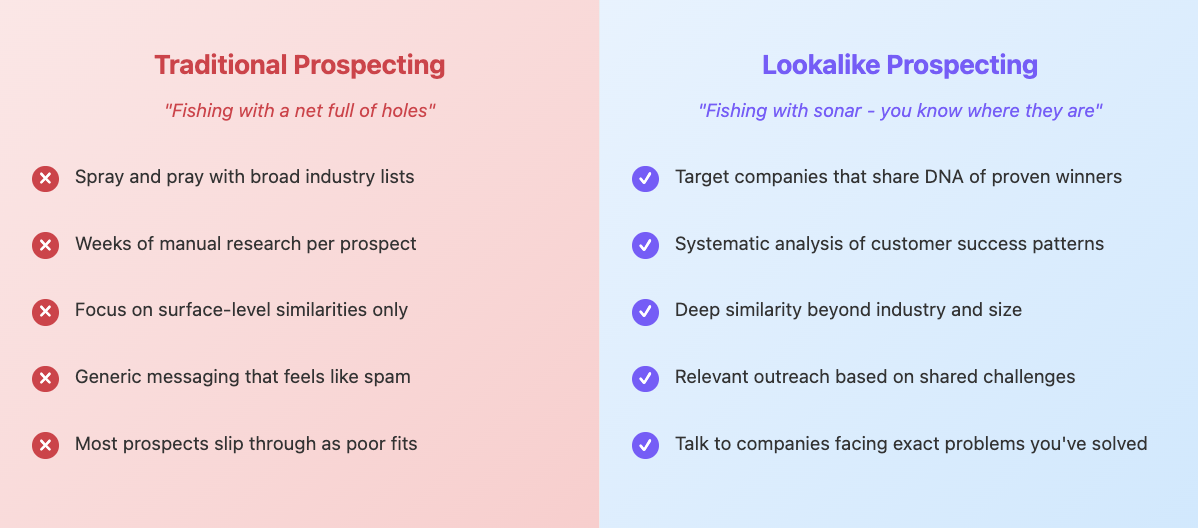
The math is compelling. Sales teams using lookalike prospecting report conversion rates 2-3x higher than traditional methods. Response rates jump from 1-2% to 5-10%. Sales cycles shrink because you're talking to companies facing the exact problems you've already solved.
But here's what most people get wrong: they think lookalikes are just about matching industry and company size. That's like saying all 6-foot-tall people are good at basketball. True lookalikes share deeper characteristics - the technology they use, the challenges they face, the way they grow, and the problems that keep their executives up at night.
What Makes Companies Truly Similar (Hint: It's Not What You Think)
Surface-level similarities are deceiving. Two 200-person software companies might look identical in a database but be completely different businesses. One sells to Fortune 500 enterprises with 18-month sales cycles. The other targets SMBs with self-serve signup. Their needs, budgets, and buying processes couldn't be more different.
Real similarity goes deeper. It's about shared challenges and parallel journeys. Companies become lookalikes when they face the same inflection points, struggle with similar growing pains, and need comparable solutions.
This pattern appears constantly in successful prospecting. A project management software company thought their ideal customer was "tech companies with 50-500 employees." But when they analyzed their happiest customers, they discovered the real pattern: companies that had recently transitioned from office-first to remote-first work. Industry didn't matter. Size was secondary. What mattered was the operational challenge they were solving.
This is why generic lookalike matching fails. You need to understand the story behind your successful customers, not just their statistics.
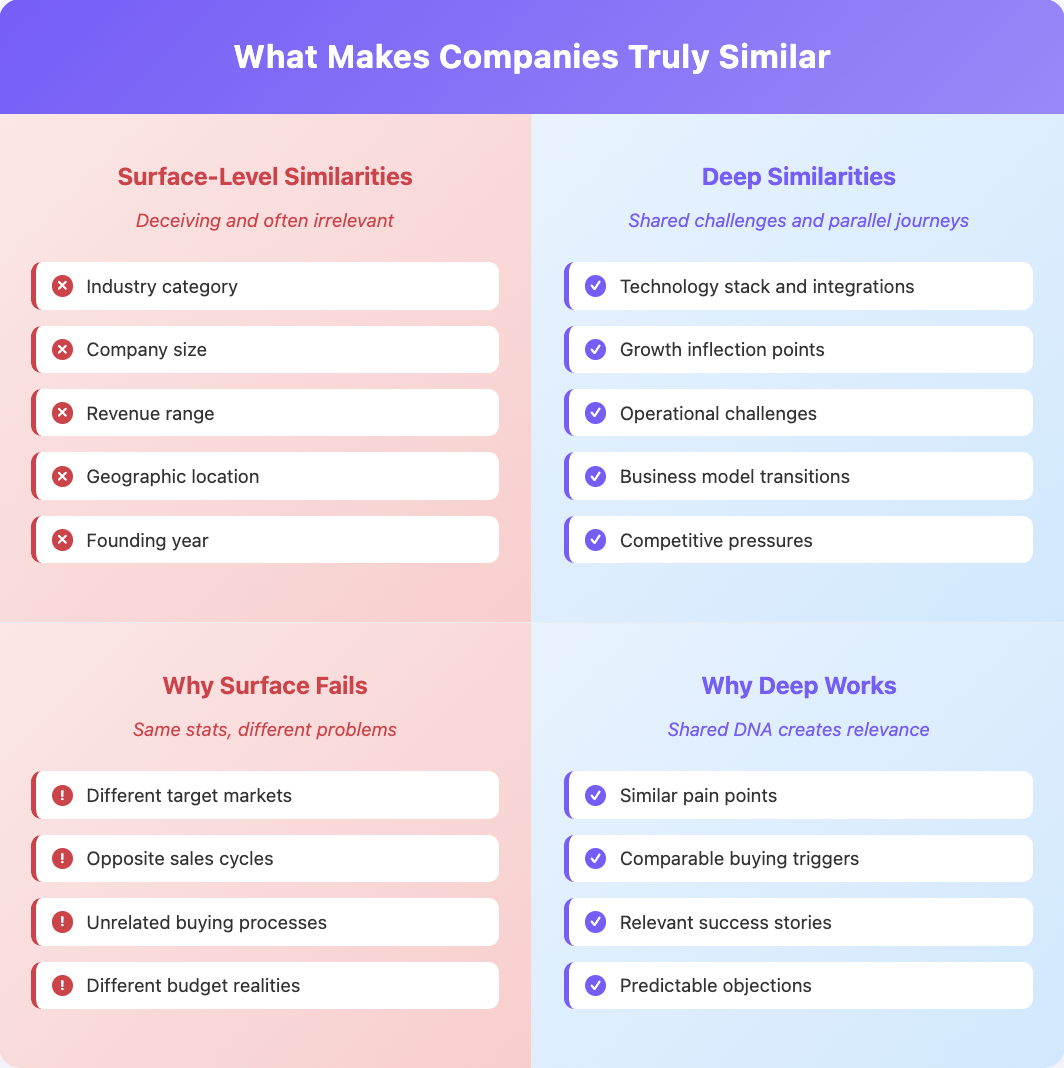
Mining Gold from Your Customer Success Stories
Before you can find lookalikes, you need to understand what you're looking for. This means going beyond surface metrics to understand why your best customers chose you and what made them successful.
Start with your top 20% of customers by revenue, retention, or advocacy. For each one, document their journey. What problem were they trying to solve when they found you? What was broken in their current process? What other solutions did they consider? Why did they choose yours?
Using comprehensive data enrichment, you can systematically analyze patterns across these success stories. Pull in their technology stacks to see what tools create integration opportunities. Analyze their hiring patterns to spot growth inflection points. Look at their funding history to understand budget availability.
The patterns that emerge often surprise people. One SaaS company discovered all their best customers had recently hired a VP of Operations - a role that typically drives process improvement initiatives. A marketing automation platform found their sweet spot was companies using Salesforce plus exactly two other marketing tools, creating just enough complexity to need their solution.
Document these patterns religiously. They become your lookalike criteria - the DNA you're searching for in new prospects.
How Modern Lookalike Technology Works
Gone are the days of manually searching LinkedIn for similar companies. Modern lookalike algorithms analyze hundreds of data points to find meaningful similarities that humans would miss.
Databar.ai integrates with leading lookalike providers including Ocean.io, DiscoLike, and PandaMatch. Each brings unique strengths to the table.
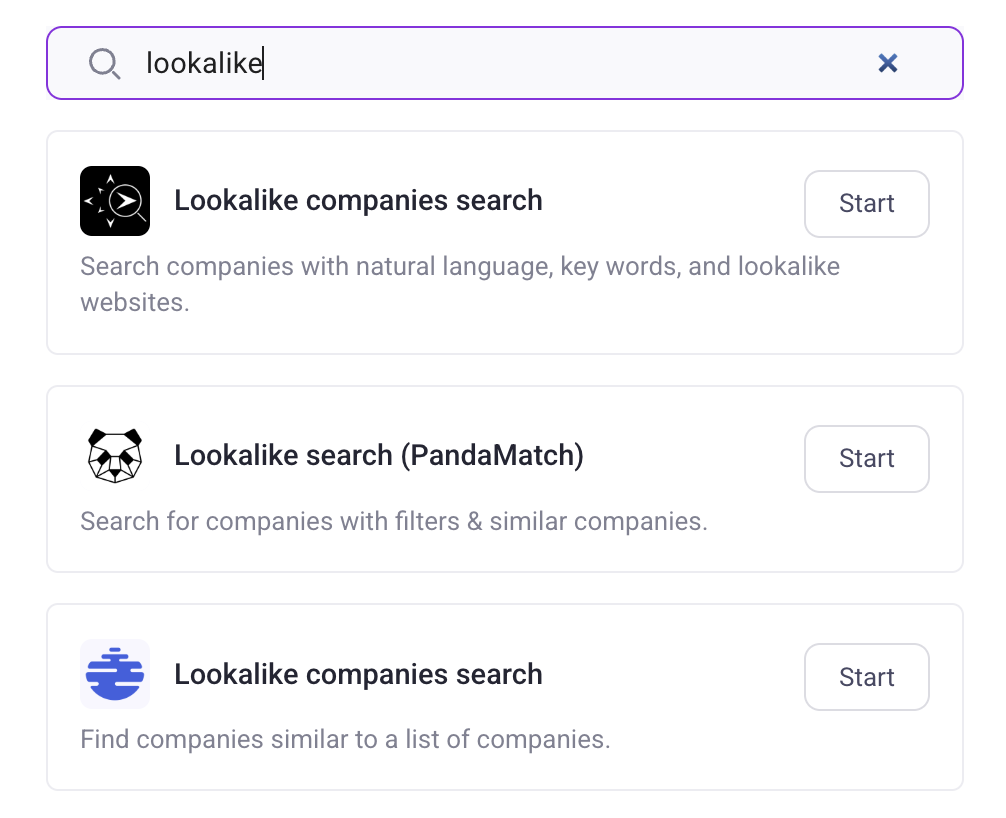
Ocean.io specializes in understanding what companies actually do, not just what industry category they fall into. Their algorithms analyze website content, job postings, and public communications to understand a company's true focus. This catches companies that might be miscategorized in traditional databases.
DiscoLike takes a technology-first approach. They map out entire tech stacks and digital footprints to find companies with similar operational DNA. If your best customers all struggle with integrating multiple marketing tools, DiscoLike finds other companies with the same challenge.
For best results you might want to layer these approaches. A company might score high on Ocean.io's market similarity but low on DiscoLike's technology match. By combining signals, you find the companies that match on all dimensions that matter.
Building Your First Lookalike Campaign: A Step-by-Step Workflow with Databar.ai
Let me walk you through exactly how to build a lookalike prospect list using Databar.ai. This process typically takes less than 10 minutes but can generate hundreds of qualified prospects.

Step 1: Prepare Your Seed Data: Start by creating a list adding your best customer companies: 5-10 domains of your most successful clients. The key is using companies that represent your ideal customer profile.
Step 2: Select Your Lookalike Tools: Click "Find Leads" and select the lookalike provider you want to use. You'll find Ocean.io, DiscoLike, and PandaMatch available.

Step 3: Configure Your Search Parameters: Set your similarity threshold (we recommend starting at 70% for quality matches). Add any geographic or industry filters that align with your target market. The lookalike tools will analyze each seed company's business model, market position, and operational characteristics.
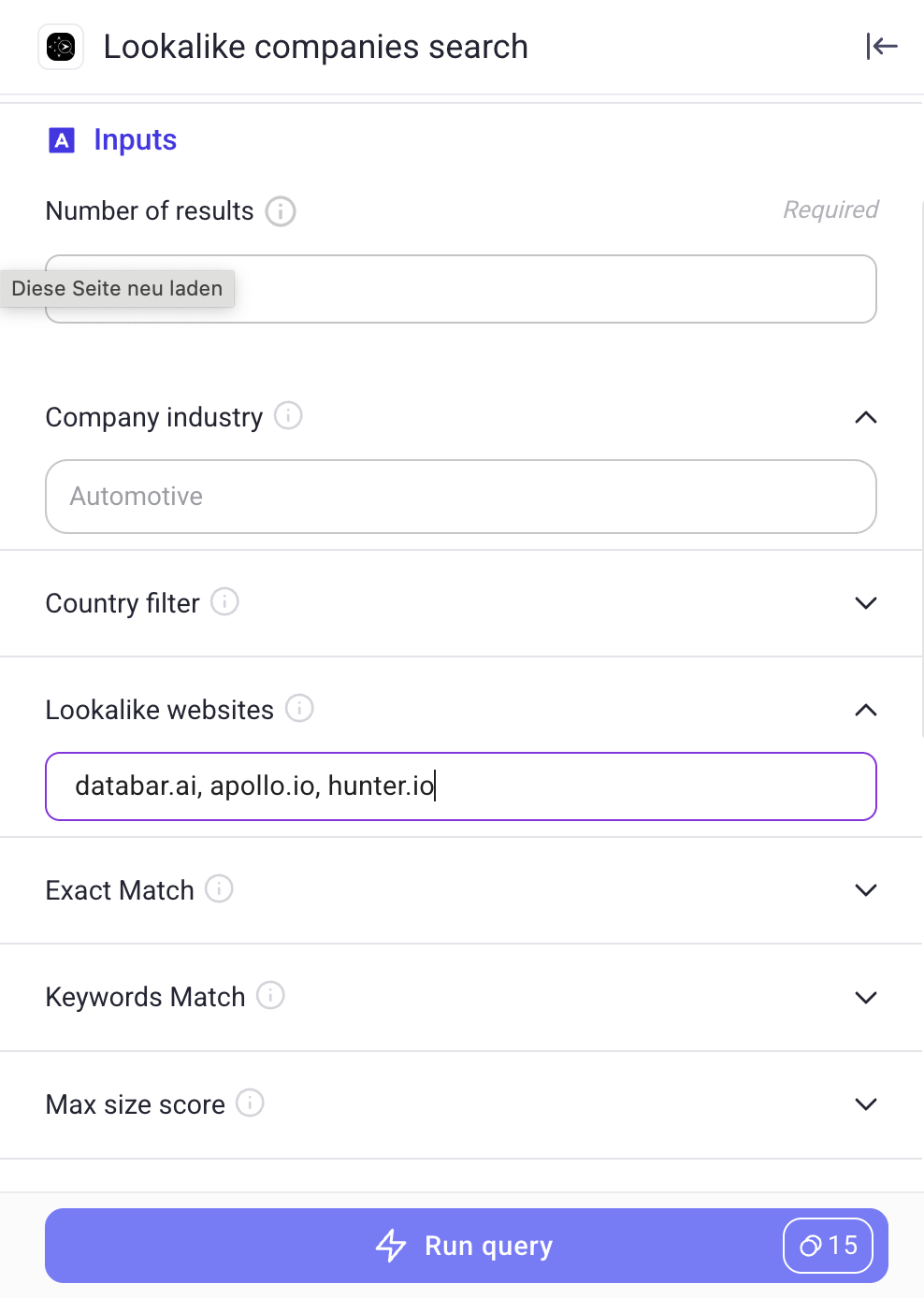
Step 4: Generate Initial Lookalike Results: Run the enrichment to receive similar companies for each seed company, complete with similarity scores and reasoning.
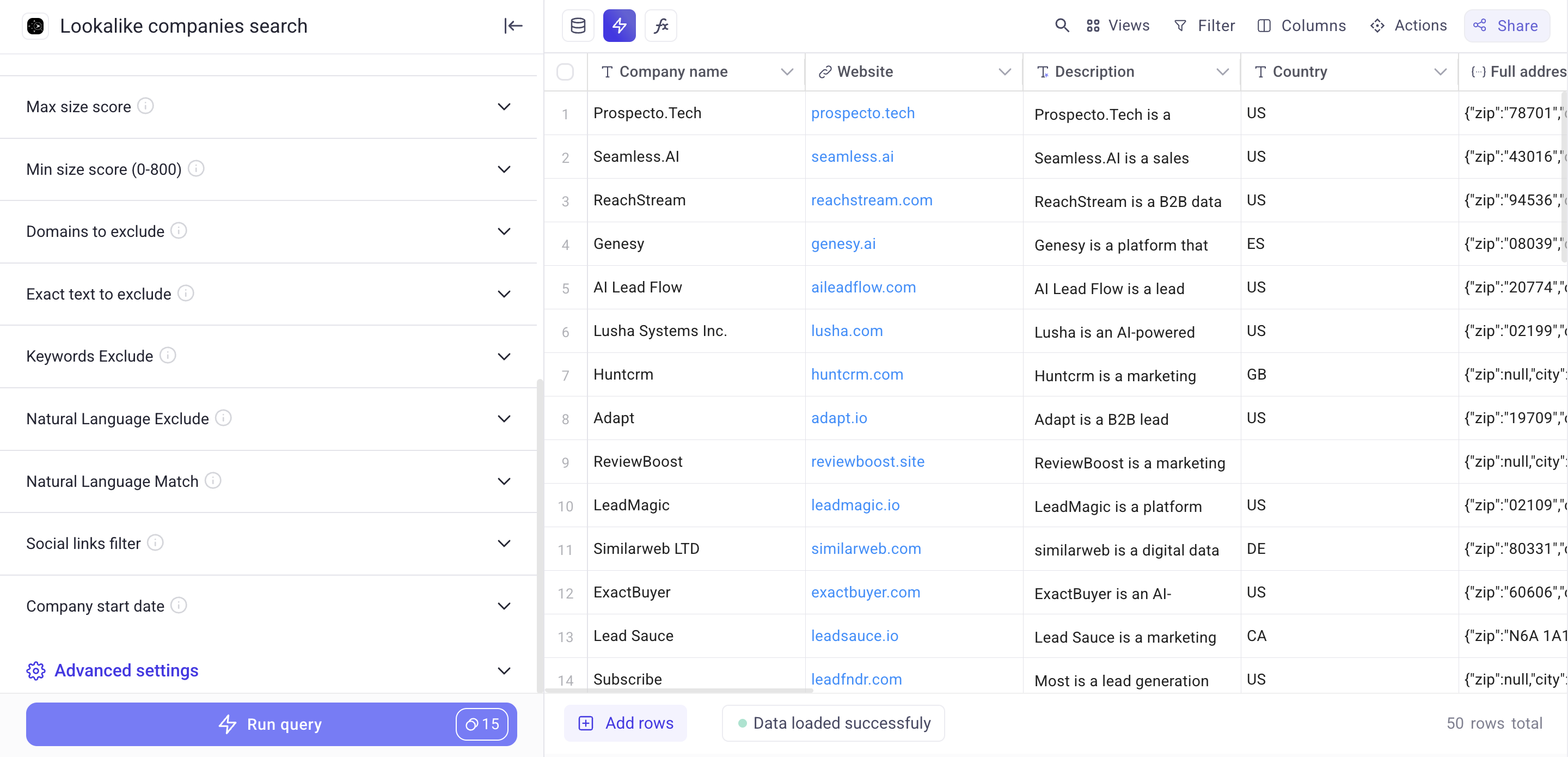
Step 5: Qualify and Score Your Results: Add enrichment columns for firmographic data, funding information, and technology usage. Use Databar's AI web scraping to visit company websites and extract specific information about their initiatives and challenges. Create a simple scoring system based on similarity scores, company size, and other qualification criteria.
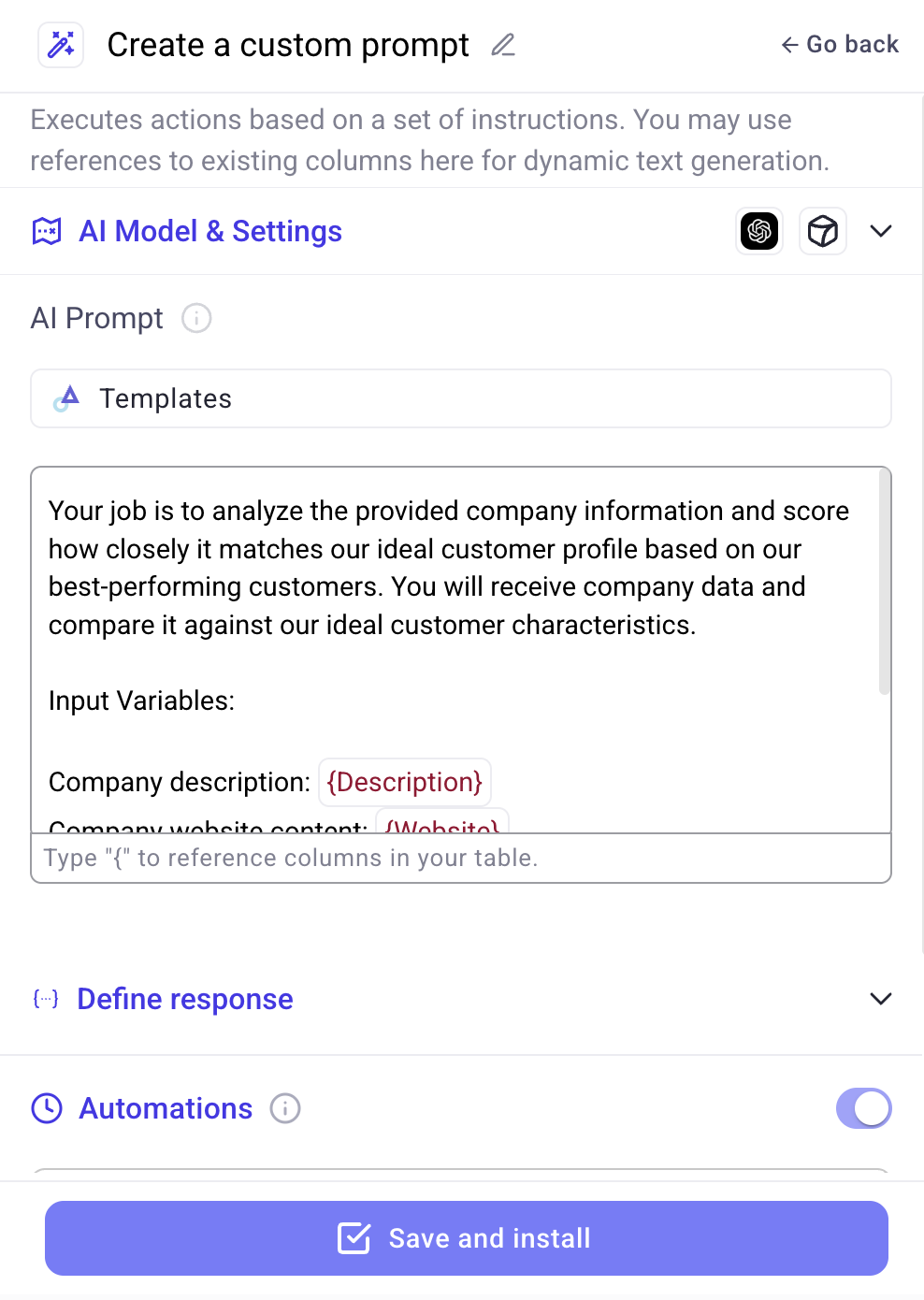
Step 7: Find Decision Makers: Use Databar's people search enrichments to identify key contacts at your highest-scoring lookalike companies. Add contact information through waterfall enrichment to maximize email discovery rates.

Step 8: Export for Outreach Push your qualified prospects directly to your CRM or email sequencing platform. You now have a targeted list of companies that share key characteristics with your best customers, complete with decision-maker contact information.
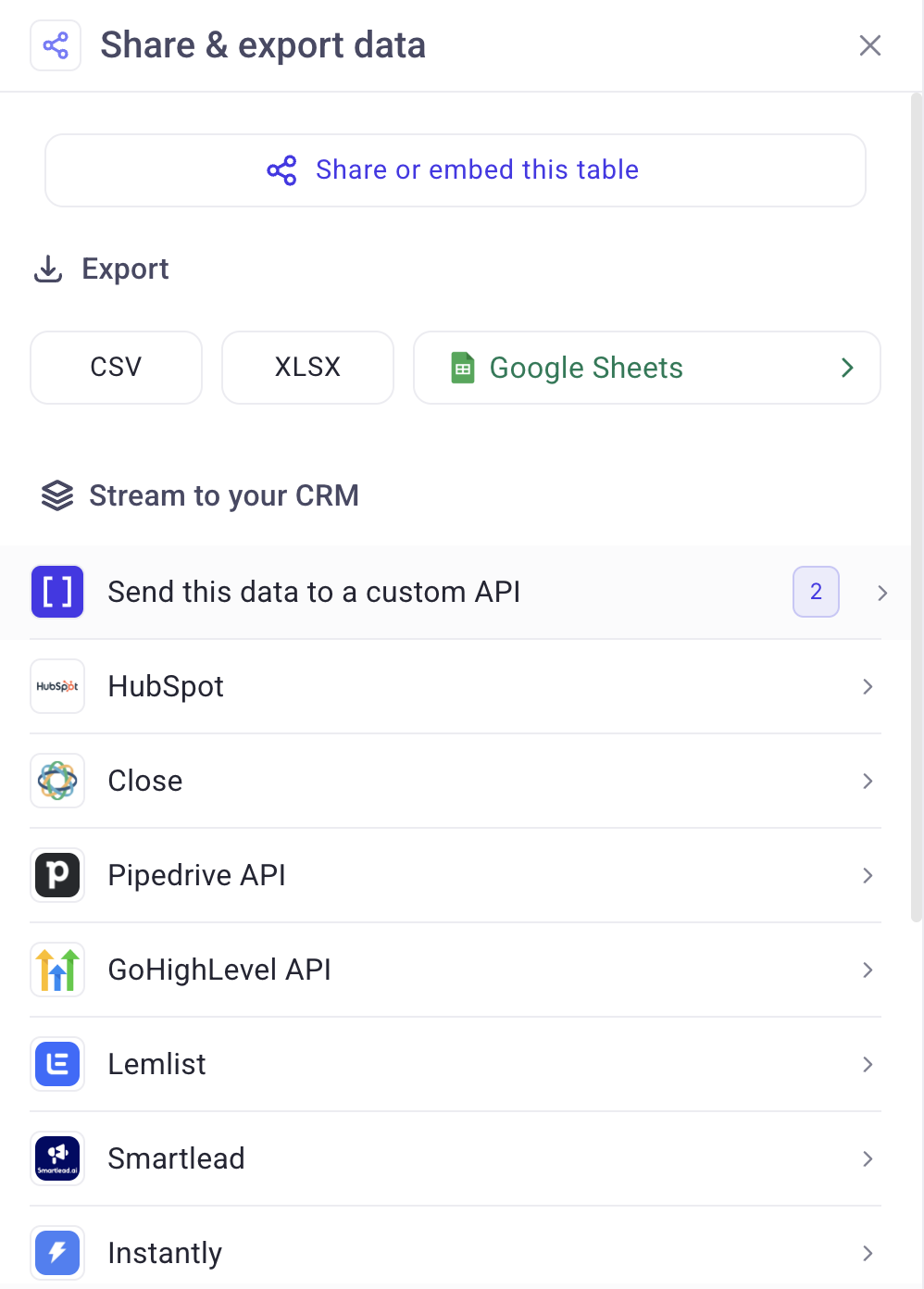
This workflow typically identifies 300-500% more qualified prospects than manual research while reducing list-building time from days to minutes.
Lookalike Outreach That Actually Works
Having a list of lookalikes is just the beginning. The power comes from crafting outreach that leverages the similarity to create immediate relevance.
Your messaging should directly reference why they're similar to your successful customer. But don't be creepy about it. Instead of "I used a computer algorithm to determine you're similar to Company X," try something more natural: "I noticed you're scaling your engineering team similar to how Company X did last year. They faced some interesting challenges around deployment velocity that I imagine might resonate with you."
This works because it's genuinely helpful. You're not cold calling with a generic pitch. You're reaching out because you've solved this exact problem before for a company in their exact situation.
Structure your entire outreach around the similarity that qualified them. If they matched based on technology stack, focus on integration challenges. If they're similar in growth trajectory, emphasize scaling pains. If they share market positioning, highlight competitive advantages.
The social proof practically writes itself. Instead of generic case studies, you can reference specific, relevant examples. "We helped three other companies in your exact situation reduce deployment time by 60% while scaling their engineering teams" carries more weight than "we help companies with DevOps."
Test different angles based on which similarity factor is strongest. A company might be a lookalike across multiple dimensions, giving you several relevant entry points for your outreach.
Scaling Beyond Your First Success
Once you've proven lookalike prospecting works, it's time to systematize and scale. This means moving from ad-hoc searches to an always-on pipeline of qualified prospects.
Start by segmenting your customer base into distinct use cases. If some customers use your product for sales enablement while others use it for customer success, create separate lookalike pools for each. The lookalikes will be more relevant and your messaging can be more targeted.
Set up recurring lookalike searches in Databar.ai. Configure monthly searches for new customers who've reached success milestones. Create quarterly refreshes of your entire lookalike database. Build alerts for when high-value lookalikes match multiple algorithms.
Track performance religiously. Which seed customers generate the best lookalikes? Which lookalike algorithms predict conversion best for your business? Which similarity factors correlate with closed deals? This intelligence helps you continuously refine your approach.
Create a feedback loop where successful lookalike customers become seeds for the next round. This virtuous cycle means your lookalike quality improves over time as you better understand what makes a perfect fit.
Don't forget about negative lookalikes. If certain customers churned or had poor experiences, use them as negative seeds to identify companies to avoid. This prevents you from repeating unsuccessful patterns.
Advanced Strategies That Separate Good from Great
The best sales teams layer sophisticated strategies on top of basic lookalike matching. These advanced techniques can dramatically improve your results.
- Time-based lookalikes focus not just on company similarity but on timing similarity. If your best customers typically buy after specific triggers like funding rounds or leadership changes, find lookalikes experiencing those same triggers right now.
- Competitive displacement lookalikes target companies similar to your competitors' unhappy customers. If you consistently win against a specific competitor, their customer base becomes a rich source of lookalike prospects.
- Technology migration lookalikes identify companies following the same tool adoption patterns as your customers. If customers typically move from Tool A to Tool B before buying your product, find companies making that transition.
- Multi-dimensional matching combines different lookalike signals to find consensus matches. Companies that score high across Ocean.io, DiscoLike, and PandaMatch typically convert at the highest rates because they match on market position, technology needs, and growth trajectory.
- Account expansion lookalikes help you grow within existing customers. If one division is successful with your product, find similar divisions within the same company or similar companies within the same corporate family.
When Lookalikes Aren't Enough: Combining Strategies
Lookalike prospecting is powerful but shouldn't be your only approach. The most successful teams combine lookalikes with complementary strategies for maximum coverage.
Layer in intent data to identify which lookalikes are actively in market. A perfect lookalike who isn't currently evaluating solutions won't convert, no matter how good the fit. Use intent signals to prioritize companies showing buying behavior.
Combine with trigger-based prospecting to catch lookalikes at the perfect moment. Set up monitoring for leadership changes, funding announcements, or technology adoptions that signal readiness to buy.
Cross-reference with your existing pipeline to avoid conflicts and identify expansion opportunities. Some lookalikes might already be in conversation with your team. Others might be current customers where you can expand to new divisions.
Use account-based strategies for high-value lookalikes. If a lookalike matches your largest enterprise customer, it might warrant a coordinated campaign across multiple stakeholders rather than single-threaded outreach.
The goal is creating multiple vectors that increase your probability of connecting with the right person at the right company at the right time.
Measuring What Matters
Track specific metrics to understand how well your lookalike strategy performs compared to traditional prospecting. This data helps you optimize and justify continued investment in the approach.
Match rate shows what percentage of generated lookalikes meet your qualification criteria. High-quality lookalike sources should produce 60-80% qualified matches after filtering. If it's lower, refine your seed selection or filtering criteria.
Conversion rate comparison reveals the true power of lookalikes. Track how lookalike-sourced prospects convert compared to traditionally sourced ones. Good programs see 2-3x higher conversion rates because the fit is so much better.
Sales cycle length often shrinks for lookalike deals because these prospects face familiar challenges. Track how quickly lookalikes move through your pipeline compared to other sources.
Customer lifetime value should mirror your seed customers. If lookalikes churn faster or buy less than the customers they resemble, something's wrong with your matching criteria.
Efficiency metrics show how much more productive your sales team becomes. How many fewer dials to get a meeting? How many fewer meetings to get a deal? This efficiency gain often justifies the entire program.
Starting Your Lookalike Journey Today
Lookalike prospecting turns random acts of sales into a systematic process for finding your next best customers. Instead of hoping prospects need what you sell, you're targeting companies that mirror your proven winners.
The path forward is clear. Identify your best customers and understand what makes them successful. Use lookalike algorithms to find their twins. Layer in additional data to qualify and prioritize. Craft outreach that leverages the similarity. Track results and continuously refine.
The companies winning in competitive markets aren't the ones making the most calls. They're the ones calling the right companies with the right message at the right time. Lookalike prospecting gives you that precision.
Ready to find hundreds of companies just like your best customers? Explore how Databar.ai brings together Ocean.io, DiscoLike, PandaMatch and 90+ additional data providers in one platform, making it simple to build prospect lists that convert like your biggest wins.
FAQ
How many customers do I need before lookalike prospecting works? You can start with as few as 5-10 customers, but they must be your absolute best - the ones you wish you had 100 more of. Using 5 perfect customers as seeds generates better results than 50 mediocre ones. As you grow, you can segment customers by use case and create more targeted lookalike pools.
What's the typical accuracy rate for lookalike matching? Modern algorithms achieve 70-85% accuracy in finding similar companies, but accuracy depends on seed quality and matching criteria. Using multiple providers like Ocean.io, DiscoLike, and PandaMatch through Databar.ai typically yields the highest accuracy by combining different similarity dimensions.
Should I tell prospects they're similar to my existing customers? Yes, but be strategic about it. Reference the similarity naturally: "I noticed you're facing similar scaling challenges to [Customer Name] when they were at your stage." This creates relevance without seeming creepy. The key is focusing on their challenges and your solutions, using the similar customer as proof you can help.
How do I avoid targeting companies that are too similar to compete? Set up filters to exclude direct competitors of your seed customers. Also consider geographic boundaries, market segments, or customer base differences. Many similar companies can coexist by serving different niches. Use your judgment - two similar HR software companies might compete, but two similar manufacturing companies probably don't.
Can I use churned customers to find companies to avoid? Absolutely. Create a "negative lookalike" list using churned or unsuccessful customers as seeds. This helps you identify and exclude companies likely to be poor fits. It's just as valuable to know who not to target as who to pursue. Run these searches quarterly to keep your exclusion list current.
What if my customers are too diverse for lookalike matching? Segment your customers by use case, industry, or success metric before running lookalike searches. You might have three distinct customer profiles that each generate their own lookalike pools. This actually improves results because the lookalikes are more targeted. Don't try to find one-size-fits-all lookalikes if your customer base is truly diverse.
Related articles
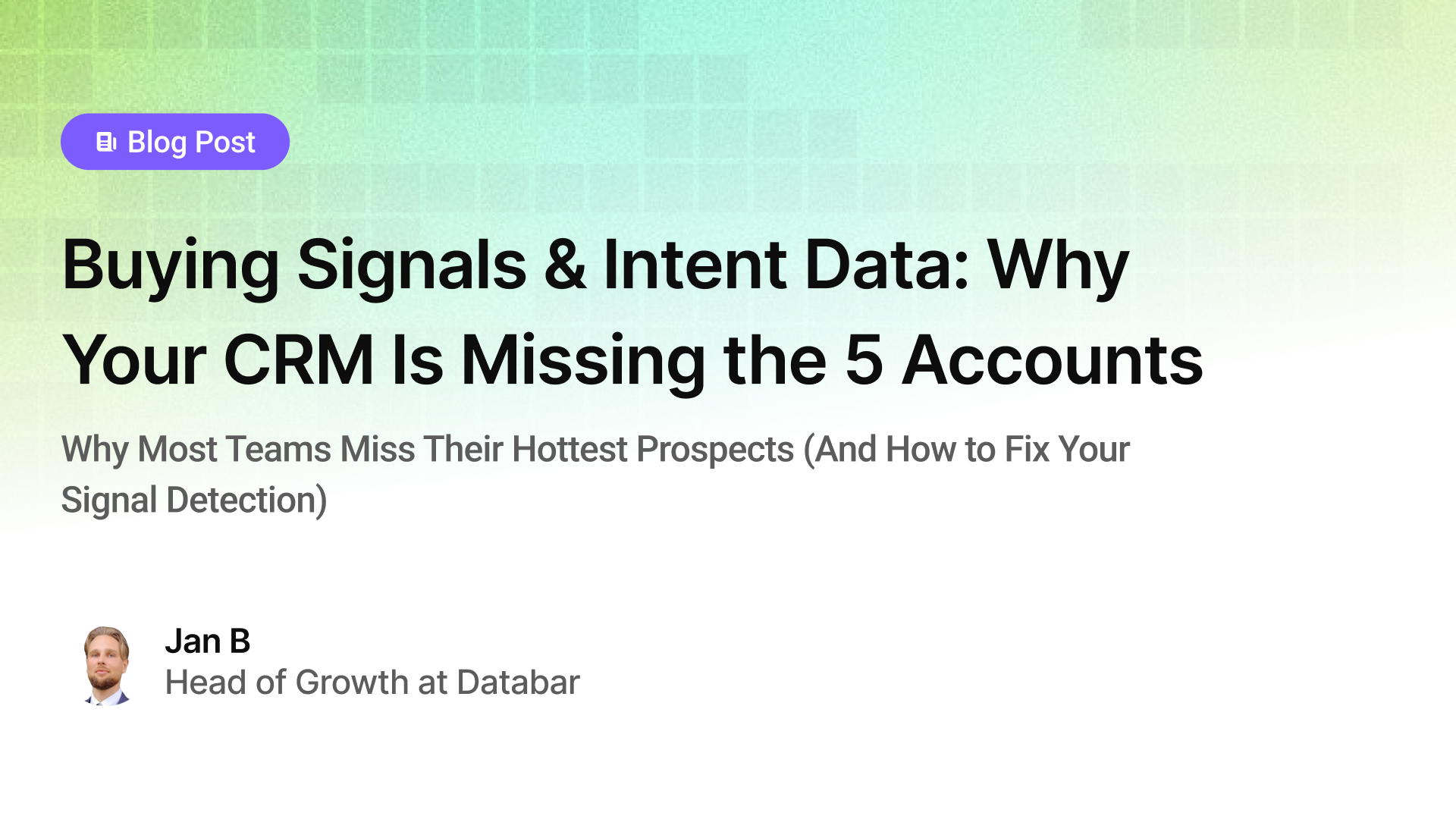
Buying Signals & Intent Data: Why Your CRM Is Missing the 5 Accounts
Why Most Teams Miss Their Hottest Prospects (And How to Fix Your Signal Detection)
by Jan, October 06, 2025

Lead Scoring & Account Segmentation: Why Most CRMs Get This Backward (And How to Fix It)
How to build a system that tells your team who to call, when, and why
by Jan, October 06, 2025
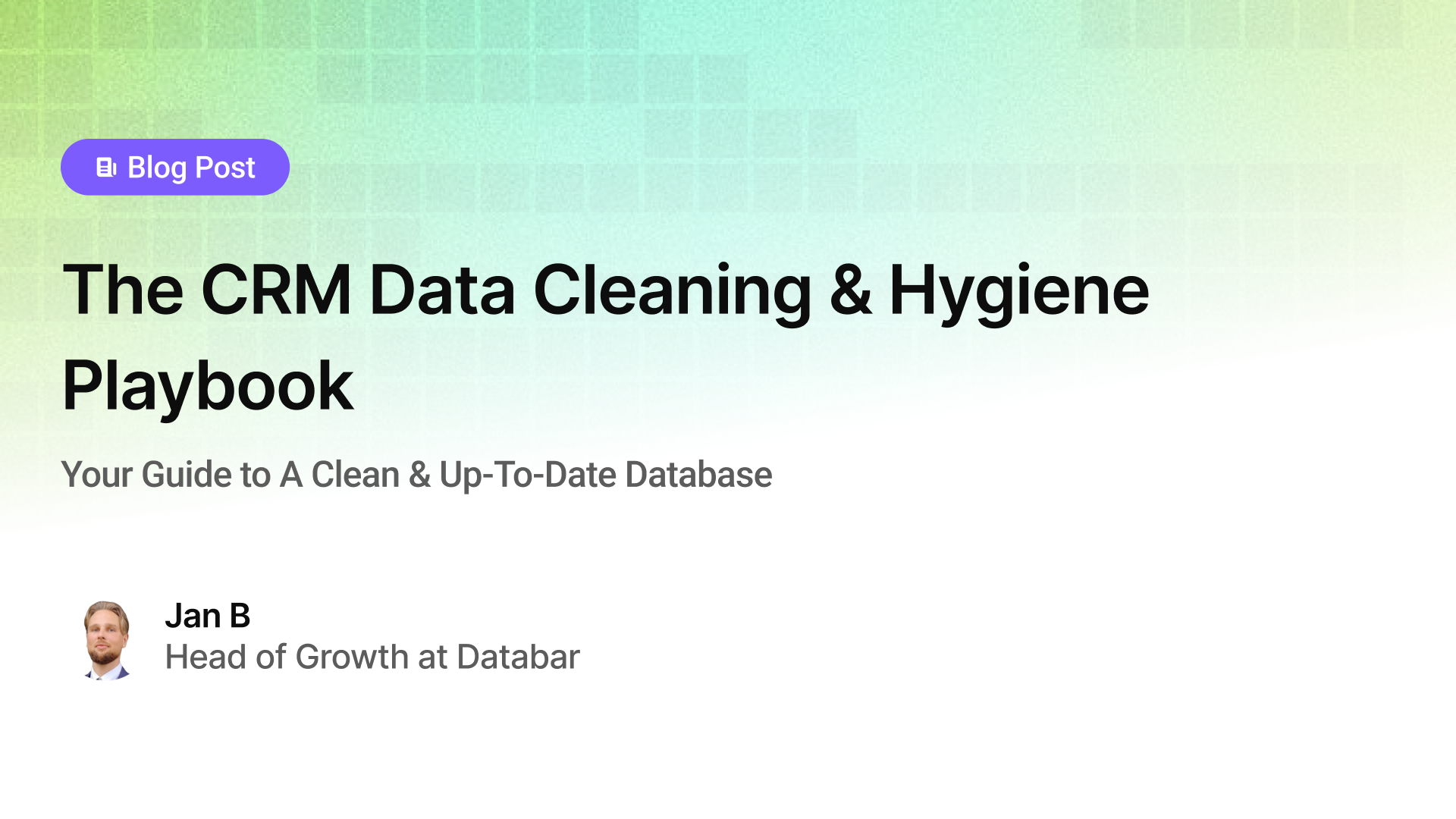
The CRM Data Cleaning & Hygiene Playbook
Your Guide to A Clean & Up-To-Date Database
by Jan, October 04, 2025
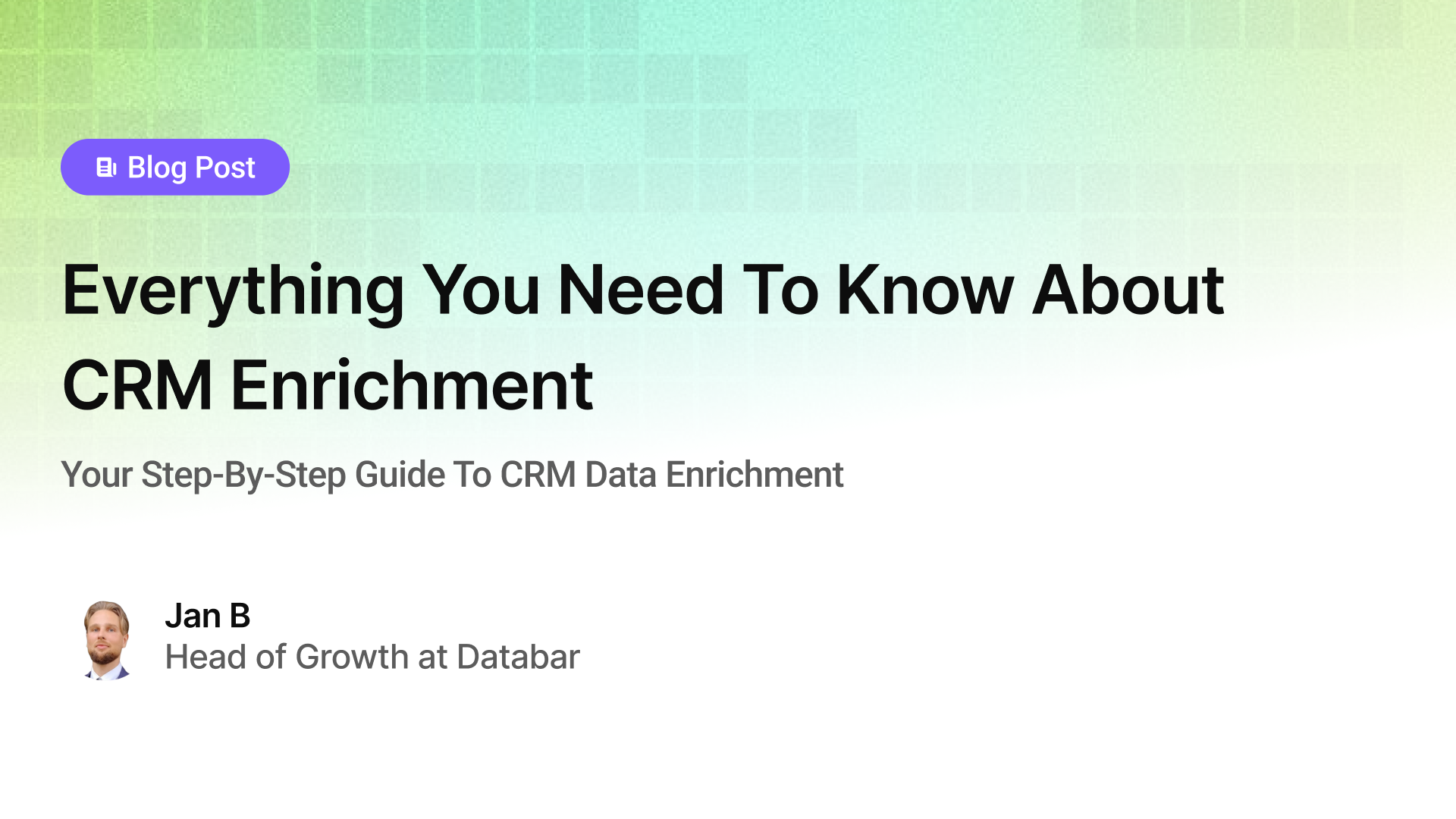
Everything You Need To Know About CRM Enrichment
Your Step-By-Step Guide To CRM Data Enrichment
by Jan, October 03, 2025

